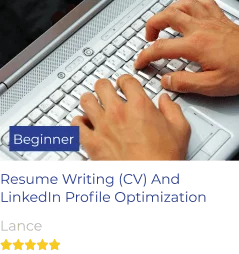Having a well-tailored resume, including all the core components, is not enough to increase your chances of being considered for an interview. In this article, you will learn the best practices for resume writing to help you get selected and land a job.
A resume is a formal document, usually one or two pages long, that sums up a person’s qualifications and experience for a job.
The purpose of a resume is to help a job seeker get considered for a job and land an interview. It is the first thing an employer sees about you making it an essential part of a job process.
Typically a resume includes:
Resume format can be done in different ways, but these core parts should always be present.
Contact information
This section is the first information to appear in your resume and should be placed at the top part. This allows the employer to see how they can contact you, so better be sure to check if your contact information is correct. Include your full name, street address, city, state, zip code, phone number, and email address. If you have a LinkedIn page, you may include that as well.
Resume summary
The resume summary goes after your contact information. It is a short statement, composed of two to three sentences highlighting your professional experience, skills, and unique qualities.
Skills
The skills section is the part of a resume that displays the abilities you have that qualify you for the job. This part would help the recruiter figure out if you got what it takes for the job.
Professional work experience
This section is where you describe your contribution to your current or past jobs and should be in reverse chronological order. Most people make mistakes in this section by listing only the job description and responsibilities instead of focusing on the achievements with the quantifiable results.
Education
For fresh graduates, the education section can be placed after the resume summary and before the skills section since you have not gained a lot of experience yet. However, if you already have work experience, you can place this section at the bottom or last part of your resume. The details should include:
- The degree you have acquired and your major or minor
- Name of your school
- Location of your school
- Year you graduated
- Your GPA (if it’s above 3.5)
Example:
2009 BA in English Literature
University of Pennsylvania, Philadelphia, PA
4.0 GPA
However, completing all your personal and professional information on each section of the resume is not enough to make your application stand out. There are best practices for resume writing that you should apply.
Tips in writing a perfect resume
1. Your resume should fit in one or two pages
The length of the resume has been an age-long debate. The truth is, it doesn’t matter if you are going to use one or two-page resumes as long as you have captured all of your qualifications on those pages in order to write an effective resume. Also, keep in mind to include only the relevant details about your experiences, accomplishments, and skills.
2. Use resume keywords
Resume keywords help recruiters find you. There are hundreds of applications that recruiters are receiving whenever they have job postings. As a result, they don’t have enough time to go through each of those applications. Instead, they use applicant tracking systems (ATS) to filter applications by using a keyword search.
To know what keywords you will be using in your resume, you need to go back to the job advertisement. For example, if they are looking for a candidate with strong communication skills, then include “strong communication skills” in your skill section. Be specific as much as possible and use keywords in phrases instead of just one word, e.g., communication. Another tip is to use the keywords on other parts or sections of your resume.
3. Use professional-looking font
It is important that you keep your font in your resume simple so that it is easy to read. Below are some of the best fonts to use for your resume.
- Calibri
- Cambria
- Garamond
- Didot
- Georgia
- Helvetica
- Arial
- Book Antiqua
- Trebuchet MS
You should also use a font size between 10 to 12 points for the body of your resume and use a larger font for your headings or sections of your resume.
4. Proofread to avoid spelling or grammar error
Writing a resume should be taken seriously. Recruiters are not impressed with applicants whose resumes have grammatical errors. That is why proofreading your resume before sending it to an employer is important. Below are some tips to help you proofread your resume.
- Print out your resume and read it.
- Read your resume aloud.
- Check your verb tense.
- Check layout consistency.
- Proofread even your personal information and, most importantly, the employer’s information.
- Ask someone to proofread your resume.
5. Include a cover letter
Many applicants are so focused on submitting a resume and skipping the cover letter, thinking that nobody will read it. Recruiters and hiring managers would love to receive a resume with a personalized cover letter. This is an important part of an application because you can add more details to cover letters that you have not included on your one- or two-page resume. It is also your chance to convince them that you are an excellent fit for the position. It makes you stand out from the rest of the applicants since most of them don’t bother sending a cover letter.
Resume writing may seem a lot to take in because there are a lot of essential steps that you should follow and factors that you should consider. Learn how to write a resume like a pro with Create The Ultimate Resume Package To Stand Out online course from Skill Success and increase the chances of an interview or job offer.
Ready to move up in your career? Click here to get started.





